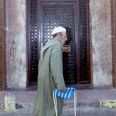
Moroccan-Jewish culture on display
'Especially with today’s tensions between Muslims and non-Muslims this exhibition is of utmost importance," says Janrense Boonstra, director of the Amsterdam Biblical Museum. 'I expect a lot of Moroccan visitors to come and I think the exhibition will be a surprise for them'
An exposition being held in Amsterdam shows the ’eternal bond’ of the Moroccan Jews with their country.
The exhibition titled "Lihoed Morocco: A Shared History," is at the Biblical Museum in Amsterdam.
For many centuries Jews and Muslims in Morocco have coexisted in harmony, and the two cultures show many similarities. Both worlds come together in the exhibition which is expressed in its title Lihoed: “Jews” in Moroccan Arabic.
The shared history is detailed through exhibits featuring like implements, clothing, films and photos. A special room is devoted to traditional Judaeo-Moroccan music as an efficient social binder and a common interest.
The exhibition is one of the last features in a series celebrating the relationship between Morocco and the Netherlands in 2005.
The friendly relationship of the two nations started in 1605, so the exhibition coincides with the 400th anniversary.
Exchanging cultures
"Especially with today’s tensions between Muslims and non-Muslims this exhibition is of utmost importance," Janrense Boonstra, director of the Biblical Museum said. "I expect a lot of Moroccan visitors to come and I think the exhibition will be a surprise for them."
The vast majority of Dutch Moroccans are Muslims and have a Berber-background. What the Dutch Muslims usually don’t know is that Jews and Berbers were living peacefully together in Morocco. There was even an important mutual cultural exchange for centuries before the arrival of Arabic culture and with the Arab conquest during the 8th century.
"For many centuries the Jewish community formed the most important minority in Morocco," Boonstra said. "Based on their culture, this community can be divided into two separate groups. The first one is the native group, the toshavim in Hebrew, who have been living in rural areas for ages."
The second group is the dispelled group, the Megorashim, who mainly lived in the cities. The Megorashim, expelled from Spain and Portugal in the fifteenth century where rich and literate.
"The difference between these two can be clearly seen in the exhibition," he said.
The exhibition was set up among others with the help of the Dutch-Moroccan Jew Sami Kaspi. Rabat-born Kaspi created the Foundation Maimon seven years ago to promote Moroccan-Jewish culture and to foster the good ties between different religions.
It was Kaspi that brought the Biblical Museum into contact with Paul Dahan from Brussels. Most of the objects used in this exhibition are from the private collection of Dahan, who owns one of the largest collections of its kind in Europe.
'Eternal bond'
"Most Moroccan Jews, like Kaspi, have a very strong, eternal bond with their tradition and heritage which is completely intertwined with the history of Morocco and the Moroccan-monarchy. That’s what we want to show," Boonstra said. “Compare them with the Russian Jews for instance. They wouldn’t think about returning to the former Sovjet Union. Moroccan Jews though return often from Israel or France to visit the graves of famous rabbis for instance.”
There are many of them in Morocco. More than 120 graves of righteous Jews are also worshipped by Muslims.
“That makes this shared history so special,” he said.
The exhibition ’Lihoed Morocco; A shared history’ will run until January 15, 2006.
Reprinted courtesy of European Jewish Press










